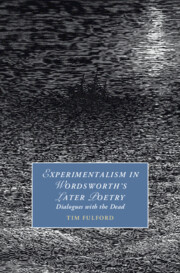Book contents
- Experimentalism in Wordsworth’s Later Poetry
- Cambridge Studies in Romanticism
- Experimentalism in Wordsworth’s Later Poetry
- Copyright page
- Contents
- Figures
- Acknowledgements
- Abbreviations
- Introduction
- Chapter 1 The Death Zone
- Chapter 2 Chronicle of a Death Untold:
- Chapter 3 Wordsworth in Homage:
- Chapter 4 Wordsworth at Sea
- Chapter 5 Dementia Poetics in Wordsworth’s Late Memorials
- Chapter 6 Wordsworth’s Bardic Vacation
- Chapter 7 Hybrids, Hermits and Hut Dwellers:
- Chapter 8 An Aged Man Writes about an Aged Man
- Bibliography
- Index
- Cambridge Studies in Romanticism
Chapter 7 - Hybrids, Hermits and Hut Dwellers:
Late Lyrical Ballads
Published online by Cambridge University Press: 15 June 2023
- Experimentalism in Wordsworth’s Later Poetry
- Cambridge Studies in Romanticism
- Experimentalism in Wordsworth’s Later Poetry
- Copyright page
- Contents
- Figures
- Acknowledgements
- Abbreviations
- Introduction
- Chapter 1 The Death Zone
- Chapter 2 Chronicle of a Death Untold:
- Chapter 3 Wordsworth in Homage:
- Chapter 4 Wordsworth at Sea
- Chapter 5 Dementia Poetics in Wordsworth’s Late Memorials
- Chapter 6 Wordsworth’s Bardic Vacation
- Chapter 7 Hybrids, Hermits and Hut Dwellers:
- Chapter 8 An Aged Man Writes about an Aged Man
- Bibliography
- Index
- Cambridge Studies in Romanticism
Summary
This last chapter discusses two of Wordsworth’s last poems, written when he was seventy-five – poems about old, poor men in their last days, approaching death. Written in 1846, these poems echo the sea poems of the mid-1830s in that they depict people who have been left lonely and isolated, in this case by the death of loved ones. Wordsworth shows extreme old age as a time of alienation, even when the aged person lives where he has always lived. His family having died, he has no one with whom to practise the daily rituals and routines that renew love and secure identity. Memory and recollection do not suffice to restore the missing presence; the self cannot sustain itself by enshrining the spirit of the past. Expressing this bleak view about the limitations of memorialisation, the poems are in dialogue with Wordsworth’s past work: they depict the aged like the sailor of ‘Composed by the Sea Shore’ and the heroine of ‘The Somnambulist’, but unlike the Wordsworth of The Prelude. They are also in dialogue with a large and noisy public campaign, in which the life, and the death, of the elderly poor was a controversial topic.
- Type
- Chapter
- Information
- Experimentalism in Wordsworth's Later PoetryDialogues with the Dead, pp. 161 - 197Publisher: Cambridge University PressPrint publication year: 2023

